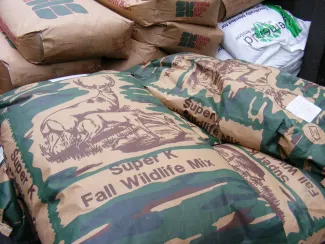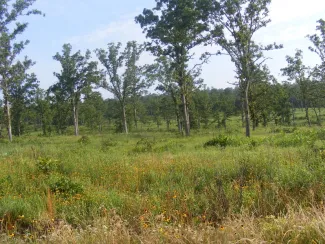Not much stirs up more controversy among wildlife biologists than the topic of food plots and the proverbial question of “What should I plant for wildlife?” It seems as if there is a common misconception that managing habitat for wildlife requires food plantings. To the contrary, good wildlife management does not require food plantings and, likewise, food plantings alone are not indicative of good wildlife management.

Food plots have specific applications and are justifiable if these applications meet your objectives. In general, food plots can be tailored for two basic objectives: 1) attracting animals to an area, and 2) increasing habitat productivity. Both uses are distinct in their management requirements and probabilities of success.
The simple fact of the matter is that wildlife utilize food plots and not being one to pass up on a cheap buffet, I can appreciate their attractiveness. Drawing animals to an area is the most functional and reliable application of food plots. Plantings of choice foods serves to concentrate animal movement within an area increasing the likelihood of sightings and harvest success. However, all too often this concentration of animals is misconceived as an increase in population density resulting in the unjust praise of food plots.
Increasing habitat productivity using food plots is intended to increase animal production (numbers and/or stature) above what the habitat can naturally support. While it seems perfectly logical that more food equals more game, science has yet to prove the ability of food plots alone to increase wildlife populations, suggesting it is a risky practice at best. When the goal is to increase habitat productivity one must take into consideration all aspects of an animal’s habitat requirements (food, cover, water, and space). For instance, a property with just enough cover to support two coveys of quail will never have more than two coveys no matter how much food you supply them with.
Plantings aimed at increasing habitat productivity must increase food availability, diversity, and nutritional quality during periods which quantity and/or quality of natural foods are deficient. This endeavor is risky because as Dale Rollins of Texas A&M says, “When you need ‘em you can’t grow ‘em and when you can grow ‘em you don’t need ‘em.” While the past few summers have been brutally dry and deer have struggled to maintain condition, food plots likely would have not supplied any relief because the dry conditions prevented them from growing.
Planting Considerations:
- Tilled seedbeds result in higher productivity and success.
- Conduct a soil test; it can save you in the long run.
- Fertilize to ensure maximum forage productivity.
- Visit with local seed dealers to see what forage varieties work best in your area.
- Planting two or more crops can provide forage over a longer period of time and increase the plot’s attractiveness to wildlife.
- When planting combinations of forage, fertilize according to the legume requirements.
- Make sure legume seeds are inoculated.
- Always fence livestock out of food plots.
- Do not plant food plots near public roads.
- Find warm and cool-season food plot options within the Oklahoma State University Wildlife Food Plot App at https://extension.okstate.edu/programs/precision-ag-and-soil-fertility/online-tools-and-apps.html.
The amount of plantings needed to elicit changes in wildlife populations limits their use for many landowners. Some suggest that increasing habitat productivity for deer with food plantings requires no less than three percent of the habitat to be planted to both warm and cool-season forages. That’s 60 acres of food plantings for every 1,000 acres of habitat. Plantings of this scale require substantial labor and financial investment and with outcomes that are marginal at best.
Manipulating native vegetation through proper grazing, prescribed burning, timber cutting, brush management and disking are less expensive practices that have a longer life expectancy. When these manipulations are used to alter structural features (cover and edge) and food production in accordance with the requirements of a specific animal, your land will have a greater influence on population characteristics than the addition of any food plot.

Managing for diverse native plant communities that provide essential food and cover is the optimum strategy when increasing wildlife populations is the goal.
Excerpts were taken from: Arkansas Food Plot Manual, Arkansas Forest Resources Center, Mike Sams, Dave Peitz and Philip Tappe.
Food Plot Thoughts for:
| White-tailed Deer | Food plots can be effective at attracting deer for increased sightings and harvest opportunities. Attempts to increase habitat productivity require both warm and cool-season plantings to supplement periods of low availability and nutritional quality of natural forages (late summer and winter through early spring). Plot size varies with the forage planted, local deer numbers, and the crops attractiveness, but generally range from ½ to five acres in size. Plots are best if irregular or long and narrow in shape being no wider than 100 yards. |
| Wild Turkey | Food plots can serve to attract birds but their ability to increase wild turkey populations is unknown. Cool-season plantings are often used in western Oklahoma to hold turkeys to an area and can supplement turkey during times natural foods may be scarce (late winter through early spring). Because of their structure (bare ground) and the insects they attract, warm-season plantings may provide valuable brood rearing habitat. Plots are commonly used by gobblers as strutting zones. Plot design is like that of deer. |
| Northern Bobwhite | Food plots are commonly used to attract and concentrate birds for harvest. Food plots can serve as an emergency food source during times of extended snow/ice coverage provided seeds remain in heads above the snow/ice. Aside from providing emergency food during times of extended snow coverage, food plots alone have not been associated with increases in quail populations. Because they typically provide overhead canopy and bare ground, warm-season plantings can provide excellent brood rearing habitat. Food plots intended for quail must be located within 50 yards of escape cover (plum thickets, briars, brush piles, etc.). For intense quail management, one ½ to one acre food plot is recommended for every 15-30 acres of quail habitat. |
This article was first shared in the Summer 2002 Your Side of the Fence from Mike Sams, former Upland Game Biologist for the Wildlife Department.